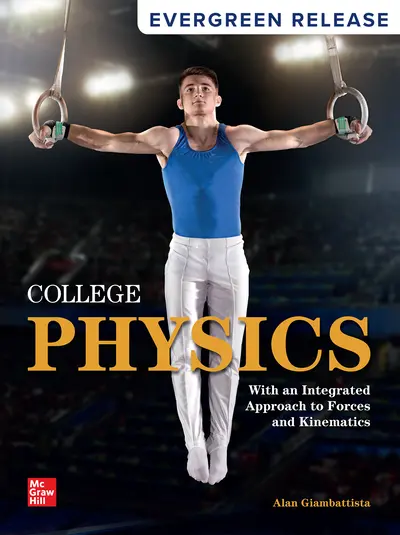My Account Details

ISBN10: 1264856725 | ISBN13: 9781264856725

* The estimated amount of time this product will be on the market is based on a number of factors, including faculty input to instructional design and the prior revision cycle and updates to academic research-which typically results in a revision cycle ranging from every two to four years for this product. Pricing subject to change at any time.
Instructor Information
Quick Actions (Only for Validated Instructor Accounts):
Alan Giambattista’s algebra-based introductory physics texts take a conceptual and intuitive approach, combined with consistent problem-solving strategies, stunning art, extensive end-of-chapter material, and superior digital support. College Physics uses an innovative forces-first presentation that integrates forces and Newton's laws into the subsequent introduction of kinematics. Physics covers the same topics but in a more traditional, kinematics-first order. The organization of chapters 2-4 is the sole difference between the two texts; the two options offer the instructor flexibility in teaching preferences.
Chapter 1: Introduction
Chapter 2: Force
Chapter 3: Acceleration and Newton’s Second Law of Motion
Chapter 4: Motion with Constant Acceleration
Chapter 5: Circular Motion
Chapter 6: Conservation of Energy
Chapter 7: Linear Momentum
Chapter 8: Torque and Angular Momentum
Chapter 9: Fluids
Chapter 10: Elasticity and Oscillations
Chapter 11: Waves
Chapter 12: Sound
PART TWO: THERMAL PHYSICS
Chapter 13: Temperature and the Ideal Gas
Chapter 14: Heat
Chapter 15: Thermodynamics
PART THREE: ELECTROMAGNETISM
Chapter 16: Electric Forces and Fields
Chapter 17: Electric Potential
Chapter 18: Electric Current and Circuits
Chapter 19: Magnetic Forces and Fields
Chapter 20: Electromagnetic Induction
Chapter 21: Alternating Current
PART FOUR: ELECTROMAGNETIC WAVES AND OPTICS
Chapter 22: Electromagnetic Waves
Chapter 23: Reflection and Refraction of Light
Chapter 24: Optical Instruments
Chapter 25: Interference and Diffraction
PART FIVE: QUANTUM AND PARTICLE PHYSICS AND RELATIVITY
Chapter 26: Relativity
Chapter 27: Early Quantum Physics and the Photon
Chapter 28: Quantum Physics
Chapter 29: Nuclear Physics
Chapter 30: Particle Physics
APPENDICES
Appendix A: Mathematics Review
A.1 Algebra
A.2 Graphs of Linear Functions
A.3 Solving equations
A.4 Exponents and logarithms
A.5 Proportions and ratios
A.6 Geometry
A.7 Trigonometry
A.8 Sinusoidal Functions of Time
A.9 Approximations
A.10 Vectors
A.11 Symbols Used in This Book
Appendix B: Reference Information
B.1 Physical Constants
B.2 Unit Conversions
B.3 SI Prefixes
B.4 SI Derived Units
B.5 Useful Physical Data
B.6 Astrophysical Data
B.7 Periodic Table of the Elements
B.8 Properties of Selected Nuclides
Answers to Selected Questions and Problems
Accessibility
Creating accessible products is a priority for McGraw Hill. We make accessibility and adhering to WCAG AA guidelines a part of our day-to-day development efforts and product roadmaps.
For more information, visit our accessibility page, or contact us at accessibility@mheducation.com
Affordability
Reduce course material costs for your students while still providing full access to everything they need to be successful. It isn't too good to be true - it's Inclusive Access.
Need support? We're here to help - Get real-world support and resources every step of the way.